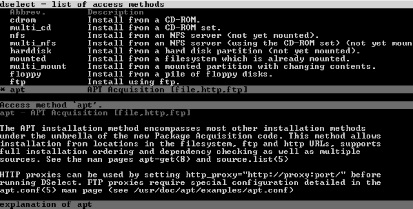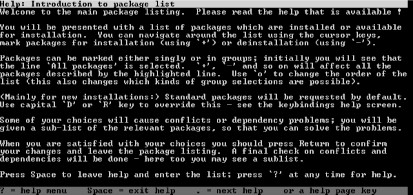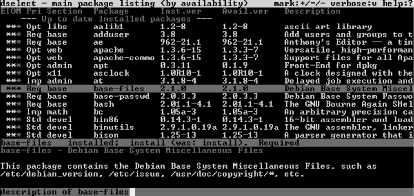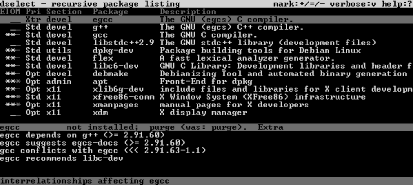
40.5. Using Debian's dselect
The dselect tool provides an easy-to-use, character-based graphical frontend for accessing dpkg (the traditional Debian installation package utility). To launch dselect, issue the command:
dselect
Figure 40-1 shows the screen that appears. The screen presents a simple menu with six items:
- Access
- Lets you choose the method used to access package files.
- Update
- Lets you update the list of available packages.
- Select
- Lets you choose packages for installation or removal.
- Install
- Initiates installation of selected packages.
- Config
- Initiates configuration of installed packages.
- Remove
- Initiates removal of packages selection for removal.
- Quit
- Exits dselect.
The menu items are generally used in the order in which they are presented.

Figure 40-1. The dselect screen
40.5.1. Choosing the Access Method
To choose the access method, use the arrow keys to highlight the Access menu item and press Enter. The screen shown in Figure 40-2 appears.

Figure 40-2. Choosing the access method
The most flexible access method -- and the method that's generally recommended -- is apt. Other available options include:
- cdrom
- Lets you install packages from a CD-ROM. This access method has been deprecated; you should use multi_cd instead.
- multi_cd
- Lets you install packages from a multivolume set of CD-ROMs.
- nfs
- Lets you install packages residing on an NFS server. This access method has been deprecated; you should use multi_nfs instead.
- multi_nfs
- Lets you install packages residing on an NFS server that has access to a multivolume set of packages.
- harddisk
- Lets you install packages residing on a hard disk partition that is not currently mounted. This access method has been deprecated; you should use apt or multi_mount instead.
- mounted
- Lets you install packages residing on a currently mounted filesystem. This access method has been deprecated; you should use apt or multi_mount instead.
- multi_mount
- Lets you install packages from a multivolume set, one volume of which is currently mounted.
- floppy
- Lets you install packages from a set of floppy diskettes.
- ftp
- Lets you install packages residing on an FTP server.
To choose an access method, use the arrow keys to highlight the appropriate menu item and press Enter.
If you selected the apt access method, you'll be asked if you want to change the sources.list file. If you've previously configured the file, you should respond No. If you've not configured the file, you can respond Yes, which initiates a dialog that builds a simple configuration. Here's a sample dialog that shows the responses you should give to install packages :
I see you already have a source list.
-------------------------------------------------------
source list displayed here: contents vary
-------------------------------------------------------
Do you wish to change it?[y/N] y
Set up a list of distribution source locations
Please give the base URL of the debian distribution.
The access schemes I know about are: http ftp file
For example:
file:/mnt/debian,
ftp://ftp.debian.org/debian,
http://ftp.de.debian.org/debian,
URL [http://http.us.debian.org/debian]: file:/cdrom
Please give the distribution tag to get or a path to the
package file ending in a /. The distribution
tags are typically something like: stable unstable frozen non-US
Distribution [stable]: stable
Please give the components to get
The components are typically something like: main contrib non-free
Components [main contrib non-free]: main contrib
Would you like to add another source?[y/N] NThe sample dialog assumes that your CD-ROM has been mounted as /cdrom. If your CD-ROM is mounted differently, you'll need to revise the dialog.
After dselect records your choice of access method, the main menu screen re- appears.
40.5.2. Updating Information on Available Packages
After selecting the access method, you should instruct dselect to update information on available packages. To do so, use the arrow keys to highlight the Update menu item and press Enter. After a short time, the main menu will re-appear.
40.5.3. Choosing Packages for Installation or Removal
Once you've updated the information on available packages, you're ready to select packages for installation or removal. To do so, use the arrow keys to highlight the Select menu item and press Enter. The screen shown in Figure 40-3 appears.

Figure 40-3. The introduction screen
This screen provides an overview of the package selection screens. When you've read its contents, press Space to go to the package selection screen, which is shown in Figure 40-4.
This screen provides an overview of the package selection screens. When you've read its contents, press Space to go to the package selection screen, whih is shown in Figure 40-4.

Figure 40-4. The package selection screen
To use the package selection screen, use the arrow keys to highlight a package in the upper part of the screen. The lower part of the screen will display information about the highlighted package. To select the package for installation, press +; to select an installed package for removal, press -.
You can search the package database by typing a slash (/) followed by the string for which you wish to search. To find successive instances of the same string, type a backslash (\). For example, to find the first package that contains the string gnome in its name or description, type /gnome and press Enter.
If you select for installation a package that requires one or more other packages that are not installed, a dependency conflict results. Similarly, a dependency conflict results if you mark for removal a package required by an installed package or if you mark for installation a package that conflicts with an installed package. When dselect detects a dependency conflict, it presents the screen shown in Figure 40-5.

Figure 40-5. The dependency help screen
The same screen appears if you select for installation a package that specifies recommended or suggested packages to be installed with it. A recommended package is one that most users install with the recommending package. A suggested package is one that is related to the suggesting package; suggested packages often extend or complement the functionality of the suggesting package.
When you press Space, you're presented with the conflict resolution screen, shown in Figure 40-6. This screen lets you quickly select for installation or removal the packages involved in a dependency conflict. The screen also presents default choices for recommended and suggested packages.

Figure 40-6. The dependency resolution screen
Using the arrow keys to highlight an entry lets you view a list of dependencies related to the entry. By pressing + or -, you can select packages for installation or removal, just as on the selection screen. When you're done working out dependencies, you can press Space to return to the selection screen.
40.5.4. Exiting the Select Function
You can select the Select function in any of several ways. Pressing Space returns you to the main menu, where you can initiate installation or removal of packages. Pressing x cancels your selections and returns you to the main menu. This feature is useful if you change your mind about installing a package, possibly owing to conflicts associated with the package.
40.5.5. Installing Packages
To begin installing the selected packages, use the arrow keys to highlight the Install menu item and press Enter. As packages are downloaded or installed, you'll see messages on the screen.
If you're using the apt access method, selecting Install actually initiates installation, removal, and configuration of packages. You can exit dselect after the installation process completes.
If you're using some other access method, dselect may not install every selected package in a single operation. When the installation process completes, you should select Install and see if more packages are installed. When you select Install and no more packages are installed, you can proceed to the subsequent steps: configuration and removal.
When the installation process is complete, dselect prompts you to press Enter to return to the main menu.
40.5.6. Configuring Packages
To begin configuring the installed packages, use the arrow keys to highlight the Configure menu item and press Enter. Packages that require configuration will prompt you for configuration choices. When the configuration process is complete, dselect prompts you to press Enter to return to the main menu.
40.5.7. Removing Packages
To begin removing the packages selected for removal, use the arrow keys to highlight the Remove menu item and press Enter. When the removal process is complete, dselect prompts you to press Enter to return to the main menu.
40.5.8. Exiting dselect
To exit dselect, use the arrow keys to highlight the Quit menu item and press Enter.
-- SP

Copyright © 2003 O'Reilly & Associates. All rights reserved.



